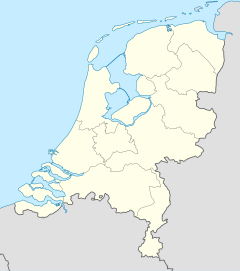You can help expand this article with text translated from the corresponding article in Dutch. (October 2024) Click [show] for important translation instructions.
|
Gouda is a railway station in Gouda, Netherlands. The station opened on 21 May 1855 when the Nederlandsche Rhijnspoorweg-Maatschappij (Dutch Rijn Railway Company) opened the Utrecht–Rotterdam railway. The Gouda–Den Haag railway to The Hague was opened in 1870, and the connection to Alphen a/d Rijn in 1934.[1]
Trains running between Den Haag Centraal / Rotterdam Centraal and Utrecht Centraal call at the station, as well as the RijnGouweLijn connection to Alphen a/d Rijn.
In November 1944, during World War II, the strategically located railway station was bombed by the Royal Air Force. The main building of the railway station was severely damaged; traces of the bombing are visible to this day on platforms 3 and 5. In 1948 a new building was constructed out of the remaining first floor of the old building.[2] This was replaced by the current building in 1984. In 2022 the building and related nearby infrastructure were renovated.[3]
- ^ "station Gouda - foto's en omschrijving op stationsweb". www.stationsweb.nl. Retrieved 2024-11-12.
- ^ "gouda". www.stationsinfo.nl. Retrieved 2024-11-12.
- ^ "Complete metamorfose stationsgebied Gouda". Complete metamorfose stationsgebied Gouda (in Dutch). Retrieved 2024-11-12.


